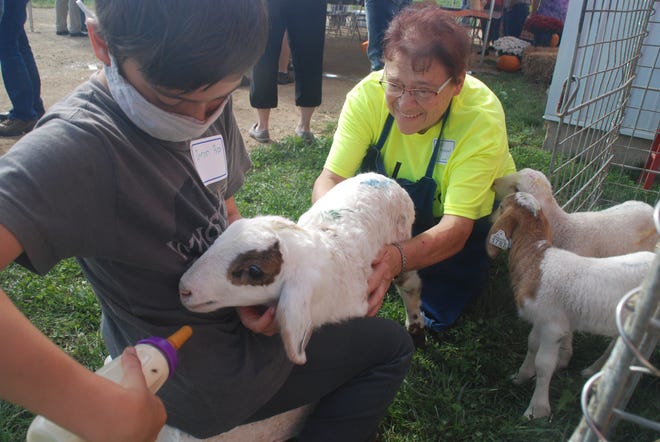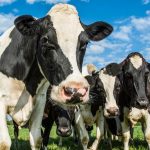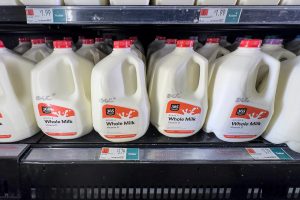
Members of the Sheep Dairy Association of Wisconsin (SDAW) gathered at a state-of-the-art sheep dairy near Juda recently to celebrate their growing industry, taste award-winning cheeses made from sheep milk and network with each other.
The hosts for the event were the partners in the new farm – called Ms. J and Co. – Jeff Wideman, Shirley Knox and Mariana Marques de Almeida, she’s the one her partners refer to as CEO. She calls herself the shepherd.
The three hatched the idea for this farm in 2014 and began planning in earnest in 2016. Their goal is the development of top quality genetics focused on the production of quality sheep and artisan cheesemaking.
The ewes are housed in pens inside a large, new barn, and are fed a total mixed ration, much like their bovine milking cousins. An attached, enclosed shed space is filled with feedstuffs and big bales of hay where a large stationery mixer is used to mix the ration. It is then elevated into a driving feed cart that runs down the aisle in front of the pens of ewes. Farm land operated by the sheep dairy’s owners includes hayfields to feed the flock.
All that hay is baled into large squares and stacked up in the feed-mixing area near the ewe barn. Viewing windows allow visitors to watch the feed mixing operation and see it get dropped in front of the ewes in their spacious pens.
Visitors can’t get up close to the animals but the farm was built with viewing windows over the feed mixing area and ewe housing pens as well as the milking parlor. The barn is now capable of housing 800 animals, but is built with a “soft wall” on the west side so that it can be removed and the barn can be doubled in size to meet their eventual flock size of 1,600. The 36-stall milking parlor was also designed so that it can be doubled.
Wideman, who grew up on a dairy farm in the area, has built a career as a cheesemaker at Maple Leaf Cheese just up the road in Monroe. He is a certified Master Cheesemaker in Cheddar and Monterey Jack. His interest in sheep dairying was spurred when he was invited to judge a cheese contest in Spain in 2008 and found it “really eye-opening.”
Marques de Almeida came to the United States in 2012 and the three partners saw an opportunity to displace imported cheese made in Spain and Italy with domestically produced sheep milk cheese. In the early years, they said, it was difficult to find enough milk to make the cheese. The sheep that were in Wisconsin at the time didn’t make enough milk to drive the system.
Years to secure genetics
Marques de Almeida said that it took years of negotiations with the USDA and European Union officials, as well as the Spanish Department of Agriculture to secure the importation of semen from the prevailing Spanish breed of dairy sheep – Assaf. Ben Brancel, who was then the Wisconsin Secretary of Agriculture, vouched for the project, she said, and helped get the officials on board.
They brought in the Assaf semen in 2017 and used it to breed the top Wisconsin milking ewes – which were East Friesian genetics that had been brought in under the auspices of the University of Wisconsin, in an effort to improve milk production.
The owners of the Ms. J and Co. flock are aiming for purebred Assaf sheep – a breed that originated in Israel and was imported to Spain in the 1970s, where genetic selection improved the breed significantly, says Marques de Almeida. Because Spanish breeders have been so devoted to the breed, they currently have the highest genetic profile of the breed, she said.
The breed is known for high milk production and its adaptability to various climates. By the end of 2022, the farm will have its fourth generation produced with Assaf genetics and that will be considered purebred. Each ewe has a microchip, allowing flock managers to have information so they can choose which rams to breed them to.
By spring of 2018, the partners were lambing those first Assaf-cross animals and feeding colostrum by hand to the ewe lambs that would form the beginning of their flock. The arrival of the first lamb coincided with construction at the farm – including their lamb rearing barn and their ewe housing, which was aided by then University of Wisconsin construction expert David Kammel.
When ewes were lambing, the partners were still in the process of building their facilities. “It was really a lot like trying the fly the plane while you’re building it,” Marques de Almeida said with a smile.
Marques de Almeida explained that they decided not to pasture their ewes based on Wisconsin’s climate and their ability to control more variables with the mixed ration and climate-controlled barn. Without putting sheep on pasture they eliminate problems with foot rot and parasites and are able to feed the ewes the same way throughout the year.
“If we were in California we would have sheep grazing,” she said.
Because they are housed in controlled conditions, the ewes can also produce lambs year-round – every two months. The flock, she explained, is divided into high, medium and low producing groups. Ewes produce milk that is up to 5.2 percent protein and 6.2 percent fat. They aim for 180-210 days in milk for their ewes
Much like a cow-dairy system, lambs are removed from their mothers immediately to break any cycle of disease, and reared in a climate-controlled barn they built up the road on the next farm. Cindy Rackow serves as the lamb rearing manager in that barn. Death losses are less than 2 percent under her care, said Marques de Almeida.
The lambs are fed colostrum from the ewes for four feedings and at that point the ewes are tested for antibiotics and their milk goes into the tank. The lambs are transitioned onto a milk replacer designed to mimic ewe’s milk.
Association formed
Brian Michielson of the SDAW said the group was formed when shepherds, cheese mongers and cheesemakers got together in Eau Claire. The nucleus of the group came from northwest Wisconsin where the University of Wisconsin had at one time operated the Spooner Sheep Station – the only one of its kind in North America. The station emphasized dairy sheep and planted the seed for the industry in Wisconsin.
Once the University closed that station in 2016 and didn’t replace the sheep production specialist, farmers and cheesemakers got together to fill that void and promote the dairy sheep industry in Wisconsin.
Michielson said that early on sheep dairy producers weren’t embraced by most dairy promotion groups or local dairy breakfast promoters but that has changed over time. “Now, with growth in the sheep dairy industry, they welcome us with open arms,” he said. The SDAW frequently makes appearances at events like June Dairy Breakfasts and cheese festivals around the state.
He and his wife Tammy and their family operate Maple Hill Farm in Ladysmith where they have 100 head of dairy sheep which are milked twice a day. Their output goes into handmade soaps, lotions and various other products, with everything made in small batches and quality ingredients. (Their farm also offers a CSA-style system including eggs, lamb, pork, grass-fed beef and pastured poultry.)
Norm Monsen, a dairy specialist with the Wisconsin Department of Agriculture, Trade and Consumer Protection, said Wisconsin has the most sheep dairies in the nation and the most dairy plants making sheep milk into cheese. “This is rural development. This is making things happen in rural Wisconsin,” he said.
Association sources report that the state has about 14 to 16 sheep dairies at any given time – some are seasonal, so the number changes. There are more cheese factories using sheep milk in a cheese recipe than there are farms producing it.

























